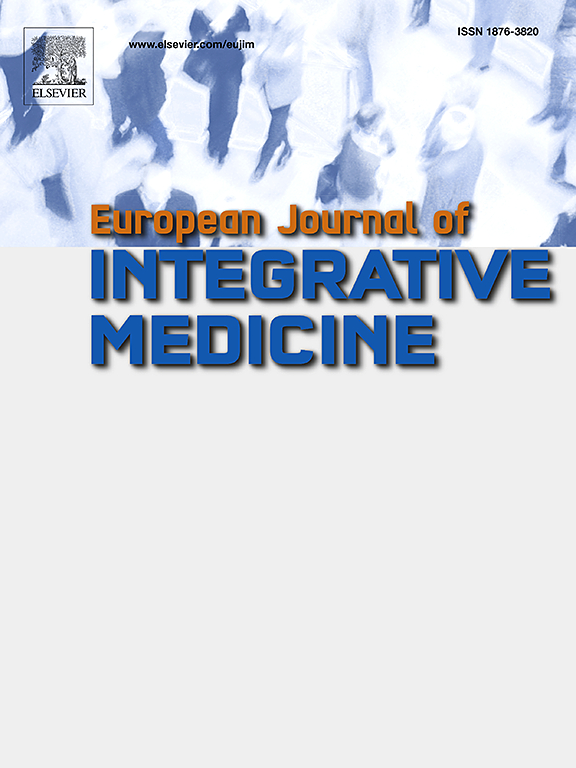阿育吠陀综合治疗方案对未控制2型糖尿病的疗效:一项随机对照研究
IF 1.7
4区 医学
Q3 INTEGRATIVE & COMPLEMENTARY MEDICINE
引用次数: 0
摘要
未控制的2型糖尿病(T2DM)普遍存在,糖化血红蛋白(HbA1C)为7%。综合阿育吠陀治疗方案(ITP)具有潜在的有益效果。本研究旨在比较ITP与标准糖尿病治疗对未控制T2DM患者的疗效。方法:随机、对照、开放标签临床研究。该研究纳入了未控制的T2DM患者(n = 200),二甲双胍(Glucophage)≥1000mg /天。患者随机分为标准治疗方案组(STP)和ITP组。STP组干预措施为二甲双胍(Glucophage)≥1000mg/天,配合饮食和生活方式措施,ITP组干预措施为二甲双胍(Glucophage)≥1000mg/天、madhumehari ghana tab(阿育吠陀药物)、阿育吠陀饮食、瑜伽90天。主要终点是HbA1C的变化。次要终点是胰岛素抵抗(HOMA IR)、空腹胰岛素、空腹血糖(FBG)、餐后血糖(PPBG)、体重、体重指数(BMI)、腰围、脂质谱、糖尿病生活质量(DQOL)、血红蛋白和血清肌酐的稳态模型评估。结果结果差异评估显示,ITP组HbA1C较STP组有显著改善(平均差异1.04,95%可信区间[CI]:1.27 ~ -0.80)。与STP相比,ITP在HOMA IR中表现出显著变化(平均差异:1.41,95% CI:2.40至-0.42),FBG(平均差异:22.25,95% CI:42.10至-14.97),PPBG (-52.27, 95% CI:70.50至-34.05),血清甘油三酯(平均差异:25.21,95% CI:42.30至-8.12),DQOL(平均差异:21.88,95% CI: 26.83至-16.92)。此外,ITP组在体重、BMI、体脂、内脏脂肪百分比和体表面积方面也有显著的结果。在两组之间的血清胰岛素、总胆固醇、极低密度脂蛋白和血清肌酐均观察到类似的结果。两组的血红蛋白%、高密度脂蛋白和低密度脂蛋白变化均不显著。两组均有轻度不良事件发生,STP组8例,ITP组4例。结论与标准治疗相比,itp干预可显著改善未控制T2DM患者的血糖参数、胰岛素抵抗参数、人体测量指标和生活质量。临床试验注册ctri /2020/12/029,762本文章由计算机程序翻译,如有差异,请以英文原文为准。
Efficacy of integrated Ayurveda treatment protocol in uncontrolled type 2 diabetes mellitus: A randomized controlled study
Introduction
Uncontrolled type 2 diabetes mellitus (T2DM), measured as glycated hemoglobin (HbA1C) of >7 %, is prevalent. An integrated Ayurveda treatment protocol (ITP) has potentially beneficial effects. This study aims to compare the efficacy of ITP with standard diabetic care in patients with uncontrolled T2DM.
Methods
This was a randomized, controlled, open-label clinical study. The study included patients (n = 200) with uncontrolled T2DM, on metformin (Glucophage) ≥1000 mg/day. Patients were randomized to either the standard treatment protocol (STP) or ITP group. The intervention in STP group was metformin (Glucophage) ≥ 1000mg/day with diet and lifestyle measures, while ITP group received metformin (Glucophage) ≥ 1000 mg /day, madhumehari ghana tab (ayurveda medicine), ayurvedic diet, and yoga for 90 days. The primary endpoint was a change in HbA1C. Secondary endpoints were homeostatic model assessment for insulin resistance (HOMA IR), fasting insulin, fasting blood glucose (FBG), postprandial blood glucose (PPBG), weight, body mass index (BMI), waist circumference, lipid profile, diabetes quality of life (DQOL), hemoglobin, and serum creatinine.
Result
Outcome difference assessment revealed significant improvement in HbA1C in ITP group compared with STP group (mean difference:1.04, 95 % confidence interval [CI]:1.27 to -0.80). ITP showed significant changes when compared to STP in HOMA IR (mean difference:1.41, 95 % CI:2.40 to -0.42), FBG (mean difference:22.25, 95 % CI:42.10 to -14.97), PPBG (-52.27, 95 % CI:70.50 to -34.05), serum triglycerides (mean difference:25.21, 95 % CI:42.30 to -8.12), and DQOL (mean difference:21.88, 95 % CI: 26.83 to -16.92). Furthermore, ITP group also demonstrated significant results in weight, BMI, body fat, visceral fat percentage, and body surface area. Comparable results were observed in serum insulin, total cholesterol, very low-density lipoprotein, and serum creatinine in between the groups. Changes were not significant for hemoglobin %, high-density lipoprotein, and low-density lipoprotein in both groups. There were mild adverse events in both groups, with 8 in STP group and 4 in ITP group.
Conclusion
ITP intervention produced significant improvements in glycemic parameters, insulin resistance parameters, anthropometric measures, and quality of life compared to standard care in uncontrolled T2DM.
Clinical trial registration
CTRI/2020/12/029,762
求助全文
通过发布文献求助,成功后即可免费获取论文全文。
去求助
来源期刊

European Journal of Integrative Medicine
INTEGRATIVE & COMPLEMENTARY MEDICINE-
CiteScore
4.70
自引率
4.00%
发文量
102
审稿时长
33 days
期刊介绍:
The European Journal of Integrative Medicine (EuJIM) considers manuscripts from a wide range of complementary and integrative health care disciplines, with a particular focus on whole systems approaches, public health, self management and traditional medical systems. The journal strives to connect conventional medicine and evidence based complementary medicine. We encourage submissions reporting research with relevance for integrative clinical practice and interprofessional education.
EuJIM aims to be of interest to both conventional and integrative audiences, including healthcare practitioners, researchers, health care organisations, educationalists, and all those who seek objective and critical information on integrative medicine. To achieve this aim EuJIM provides an innovative international and interdisciplinary platform linking researchers and clinicians.
The journal focuses primarily on original research articles including systematic reviews, randomized controlled trials, other clinical studies, qualitative, observational and epidemiological studies. In addition we welcome short reviews, opinion articles and contributions relating to health services and policy, health economics and psychology.
 求助内容:
求助内容: 应助结果提醒方式:
应助结果提醒方式:


